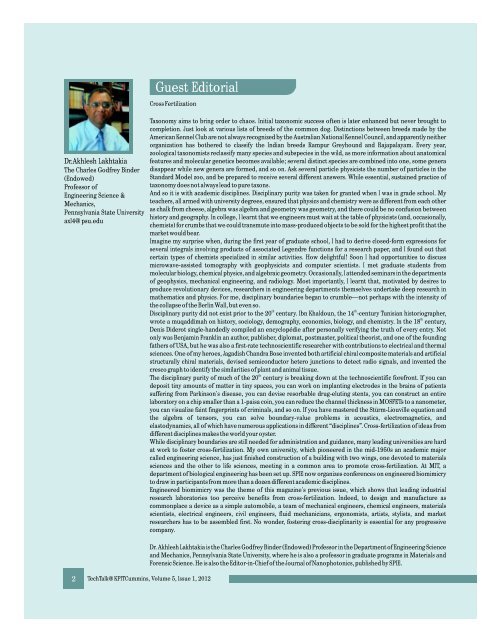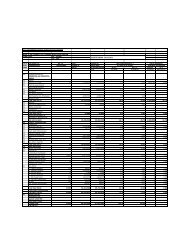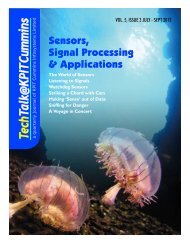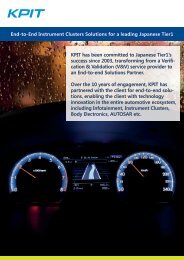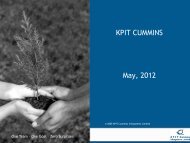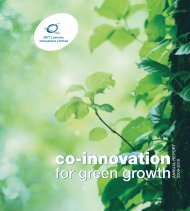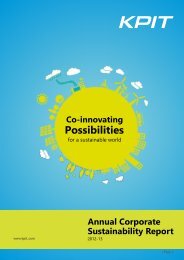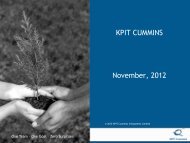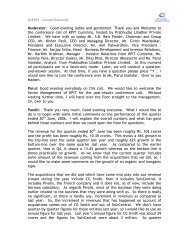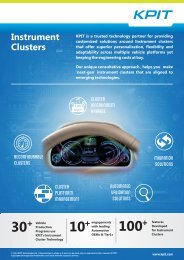INNOVATIONS FROM THE EDGE - KPIT
INNOVATIONS FROM THE EDGE - KPIT
INNOVATIONS FROM THE EDGE - KPIT
You also want an ePaper? Increase the reach of your titles
YUMPU automatically turns print PDFs into web optimized ePapers that Google loves.
Dr.Akhlesh Lakhtakia<br />
The Charles Godfrey Binder<br />
(Endowed)<br />
Professor of<br />
Engineering Science &<br />
Mechanics,<br />
Pennsylvania State University<br />
axl4@psu.edu<br />
Guest Editorial<br />
Cross Fertilization<br />
Taxonomy aims to bring order to chaos. Initial taxonomic success often is later enhanced but never brought to<br />
completion. Just look at various lists of breeds of the common dog. Distinctions between breeds made by the<br />
American Kennel Club are not always recognized by the Australian National Kennel Council, and apparently neither<br />
organization has bothered to classify the Indian breeds Rampur Greyhound and Rajapalayam. Every year,<br />
zoological taxonomists reclassify many species and subspecies in the wild, as more information about anatomical<br />
features and molecular genetics becomes available; several distinct species are combined into one, some genera<br />
disappear while new genera are formed, and so on. Ask several particle physicists the number of particles in the<br />
Standard Model zoo, and be prepared to receive several different answers. While essential, sustained practice of<br />
taxonomy does not always lead to pure taxons.<br />
And so it is with academic disciplines. Disciplinary purity was taken for granted when I was in grade school. My<br />
teachers, all armed with university degrees, ensured that physics and chemistry were as different from each other<br />
as chalk from cheese, algebra was algebra and geometry was geometry, and there could be no confusion between<br />
history and geography. In college, I learnt that we engineers must wait at the table of physicists (and, occasionally,<br />
chemists) for crumbs that we could transmute into mass-produced objects to be sold for the highest profit that the<br />
market would bear.<br />
Imagine my surprise when, during the first year of graduate school, I had to derive closed-form expressions for<br />
several integrals involving products of associated Legendre functions for a research paper, and I found out that<br />
certain types of chemists specialized in similar activities. How delightful! Soon I had opportunities to discuss<br />
microwave-assisted tomography with geophysicists and computer scientists. I met graduate students from<br />
molecular biology, chemical physics, and algebraic geometry. Occasionally, I attended seminars in the departments<br />
of geophysics, mechanical engineering, and radiology. Most importantly, I learnt that, motivated by desires to<br />
produce revolutionary devices, researchers in engineering departments themselves undertake deep research in<br />
mathematics and physics. For me, disciplinary boundaries began to crumble––not perhaps with the intensity of<br />
the collapse of the Berlin Wall, but even so.<br />
th<br />
th<br />
Disciplinary purity did not exist prior to the 20 century. Ibn Khaldoun, the 14 -century Tunisian historiographer,<br />
th<br />
wrote a muqaddimah on history, sociology, demography, economics, biology, and chemistry. In the 18 century,<br />
Denis Diderot single-handedly compiled an encyclopédie after personally verifying the truth of every entry. Not<br />
only was Benjamin Franklin an author, publisher, diplomat, postmaster, political theorist, and one of the founding<br />
fathers of USA, but he was also a first-rate technoscientific researcher with contributions to electrical and thermal<br />
sciences. One of my heroes, Jagadish Chandra Bose invented both artificial chiral composite materials and artificial<br />
structurally chiral materials, devised semiconductor hetero junctions to detect radio signals, and invented the<br />
cresco graph to identify the similarities of plant and animal tissue.<br />
th<br />
The disciplinary purity of much of the 20 century is breaking down at the technoscientific forefront. If you can<br />
deposit tiny amounts of matter in tiny spaces, you can work on implanting electrodes in the brains of patients<br />
suffering from Parkinson's disease, you can devise resorbable drug-eluting stents, you can construct an entire<br />
laboratory on a chip smaller than a 1-paisa coin, you can reduce the channel thickness in MOSFETs to a nanometer,<br />
you can visualize faint fingerprints of criminals, and so on. If you have mastered the Stürm-Liouville equation and<br />
the algebra of tensors, you can solve boundary-value problems in acoustics, electromagnetics, and<br />
elastodynamics, all of which have numerous applications in different “disciplines”. Cross-fertilization of ideas from<br />
different disciplines makes the world your oyster.<br />
While disciplinary boundaries are still needed for administration and guidance, many leading universities are hard<br />
at work to foster cross-fertilization. My own university, which pioneered in the mid-1950s an academic major<br />
called engineering science, has just finished construction of a building with two wings, one devoted to materials<br />
sciences and the other to life sciences, meeting in a common area to promote cross-fertilization. At MIT, a<br />
department of biological engineering has been set up. SPIE now organizes conferences on engineered biomimicry<br />
to draw in participants from more than a dozen different academic disciplines.<br />
Engineered biomimicry was the theme of this magazine's previous issue, which shows that leading industrial<br />
research laboratories too perceive benefits from cross-fertilization. Indeed, to design and manufacture as<br />
commonplace a device as a simple automobile, a team of mechanical engineers, chemical engineers, materials<br />
scientists, electrical engineers, civil engineers, fluid mechanicians, ergonomists, artists, stylists, and market<br />
researchers has to be assembled first. No wonder, fostering cross-disciplinarity is essential for any progressive<br />
company.<br />
Dr. Akhlesh Lakhtakia is the Charles Godfrey Binder (Endowed) Professor in the Department of Engineering Science<br />
and Mechanics, Pennsylvania State University, where he is also a professor in graduate programs in Materials and<br />
Forensic Science. He is also the Editor-in-Chief of the Journal of Nanophotonics, published by SPIE.<br />
2<br />
TechTalk@<strong>KPIT</strong>Cummins, Volume 5, Issue 1, 2012


